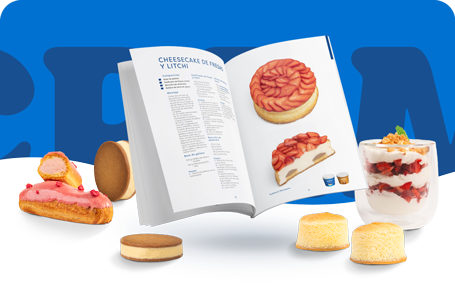Within the world of catering, the Spanish tapa is undoubtedly one of the most popular formats among customers who visit bars and taverns throughout our country and abroad. The tapa is one of the main ambassadors of Spanish gastronomy, a small bite that has given rise to a verb, to go out for tapas . A whole way of leisure and life that has become the image of the Spain Brand at the same level as olive oil or Iberian ham, and that is successfully exported beyond our borders.
The Spanish tapa is a perfect gastronomic format within the reach of almost any hospitality business, since it adapts to many types of establishments and cooking styles. The tapa also stands out for its versatility, good profitability and easy consumption, as it combines immediacy and individual format. The latter is of great help in adapting to the Covid-19 protocols that have been imposed in recent months in catering businesses around the world. Another indisputable advantage of the tapa over other formats is that you can offer your customers the opportunity to try more variety of dishes without spending a lot of money or being overly full. In this article we will cover all the key points on how to successfully incorporate tapas into your business, wherever you are in the world.
Tapas and their importance in Spanish gastronomy
What is a tapa? What does it mean to go out for tapas in Spain? Let’s take it one step at a time. According to the Real Academia Española de la Lengua, a tapa is defined as a “small portion of food served as an accompaniment to a drink”. In other words, the tapa is a small bite that we can take at the bar when we have a drink. It seems that in the origins of the “tapa” was the old custom in taverns to “cover” the glasses with a slice of bread or slice of ham, to prevent insects or dust from entering. Whether this is true or not, the truth is that the art of the tapa has become a curious form of miniature gastronomy and an essential part of Spain’s cultural identity.
Throughout the Spanish geography we find different names for the Spanish tapa. Thus, in the northern regions such as La Rioja, Navarra or the Basque Country, we usually find them under the denomination of “pincho” or “pintxo”, another name for the tapa. Also in some cities it is customary to offer what is called an “aperitif” as a courtesy of the house, to whet the appetite and accompany the drink, which can be called “tapa de cortesía”.
In our country, going out for tapas or going out for tapas is a deeply rooted custom that translates into going out with family and friends to have these small bites accompanied by a drink, as an aperitif before lunch or dinner. A tradition that can take various forms and that has evolved along with Spanish society.
One of the most classic forms of tapas among Spaniards is to eat tapas standing up, tasting the different specialties of different bars and taverns. Instead of sitting down to eat in a single establishment, Spaniards sometimes prefer to taste different specialties standing up and going on a tour of several bars and taverns in their neighborhood or city. However, the enormous success of the tapas format has led to a leap from the bar to the table in restaurants that offer a wide range of tapas that can be enjoyed at the bar, at high tables, or seated at tables. We no longer speak of the tapa as a small bite before a main meal, but as part of a complete menu or meal and consumed seated at the table.
The tapas culture is so deeply rooted in Spain that it has gone beyond cultural and social aspects, becoming part of the tourist promotion of many of our cities and regions and expressing their gastronomic variety and richness. There are a multitude of tapas fairs coinciding with many of the popular Spanish festivals, where local products and elaborations are promoted through the tapas format. In the fairs or tapas routes, there is usually an established route, each bar or restaurant has a typical tapa, and there may also be a tapas contest in which visitors choose the best tapas in one or more categories. Many of these annual celebrations coincide with the arrival of good weather, as is the case of the Tuna Gastronomic Week in Barbate (Cádiz, Andalusia), the Octopus Festival in Carballiño (Orense, Galicia), the Ribeiro Wine Fair (Ribadavia, Galicia) or La Tomatina de Buñol (Valencia, Valencian Community) to give some examples. There are also tapas contests in which the best creative tapas are awarded, generally based on one or several typical ingredients of the area. There are both at national level, such as the National Contest “Tapas Alimentos de España“; or held at regional level or in specific cities. This is the case of the famous National Contest of Pinchos and Tapas or the World Tapas Championship, both held in the city of Valladolid (Castilla y León). Further north and in a region with a long tradition in pinchos is the Concurso de Pinchos de La Rioja with almost 20 years in its edition.
We cannot forget the tapas tours, so popular with tourists and designed to make a tour of the restaurants in certain neighborhoods or areas of cities. In them, not only the gastronomy is enjoyed, but also and at the same time, the main tourist attractions. Cities such as Madrid, Barcelona, Seville, Granada or Malaga have a wide range of tapas tours, where a local guide usually designs a route that allows tourists, especially foreigners, to get into the most typical of the city.
In this line, next June 17 will be held the 5th edition of the World Tapas Day, an initiative promoted by the Taste Spain Association that promotes the Spanish tapa as one of the main tourist attractions of our country. Its objective is to highlight the value of Spanish tapas both inside and outside our borders. Several actions will be carried out throughout the day in which the tapa will be the main protagonist.
Types of tapas, options for all businesses and tastes
There are a large number of categories of tapas for all types of customers and their preferences. But they are not only adaptable to the customer, but also to the philosophy and style of any hospitality establishment whatever the type of business. Let’s take a look at some of these main categories:
According to its format. We can find caps in every conceivable shape. Big and small, simple and sophisticated. From a simple plate of olives, a bit of ham or a bit of cheese with bread, to small sandwiches, known in the south of Spain as montaditos. Going through brochettes and tapas of some typical elaboration of the city or region in which we are, served in small clay pots. To more complex tapas with a more modern presentation.
Depending on the temperature at which they are served. We can find both hot and cold tapas. Cold tapas usually stand out for their immediacy of service and range from snacks that do not require any preparation and are served directly, such as pickles or cold meats: olives, Manchego cheese, Iberian ham, pickled mussels, gilda, etc. On the other hand, there are the tapas that do require a minimum previous preparation. After preparation, these tapas can be kept in refrigerated display cabinets and offered to the customer when the kitchen is not yet open. A clear example of this are anchovies in vinegar, salad, potato dressings, etc.
All these advantages facilitate better time management in combination with hot tapas, which are served freshly cooked or heated instantly. The examples of hot tapas are innumerable, from the classic legume stews such as fabada (beans), or of offal such as tripe with chickpeas. Also fried foods such as ham croquettes, papas bravas; or fish and seafood such as fried anchovies or prawns with garlic, etc. There is also a place in this type of tapas for innovative tapas, those in which modernity and tradition are mixed, such as mini squid burgers with aioli or rice with a special touch fusing several cultures such as Manchego cheese risotto, etc.
The famous potato omelette tapa deserves a special mention, one of Spain’s star tapas that can be served cold, warm or even freshly made while still steaming. In each region or city we can find different versions of the potato omelette, sometimes with onion or without it, with the egg more curdled or almost liquid as the famous Galician Betanzos omelette. . Potato omelette with onion or without onion? This is one of the classic gastronomic questions that divides Spaniards and generates an amusing controversy. In addition, the Spanish tortilla de patatas can include other ingredients in its filling, such as ham, chorizo or cheese, to give just a few examples.
Depending on the cooking style. We can find classic tapas for more traditional establishments and clientele, such as Spanish potato omelette, fried foods like croquettes or patatas bravas. Gourmet tapas, with a great success of public in the last years. Gourmet tapas adopt ingredients and elaboration methods from haute cuisine to the small format. They are the undisputed star of businesses such as gastrobars or gastrotaverns that attract a more gourmet clientele or more eager to try something new. Nor can we forget the fusion tapas that incorporate ingredients and formats from various gastronomic cultures (Peruvian-Japanese or Mexican-Chinese fusion), which are very popular with the younger clientele.
According to the origin of the ingredients. Here we can find tapas elaborated mainly with local products of proximity, with ingredients of organic origin or simply opting for healthy ingredients whatever their origin. Tapas made with this type of ingredients are typical of the slow food trend that has also reached tapas establishments.
According to their price. We can distinguish between complimentary tapas whose cost is included in the drink ordered. In some establishments the tapas offered are fixed according to the number of rounds of drinks ordered by the customer. Normally, in these cases, as the number of rounds of drinks ordered increases, the tapa is more abundant and/or more complex in its preparation than the previous one. This is usually the case in tapas bars in cities such as Granada and Jaén in southern Spain. However, there are also tapas establishments that have a list of complimentary appetizers and the diner can choose the one he likes every time he orders a drink. This is the case of most tapas bars in Lugo in Galicia, Salamanca, León and Ávila in the Castilla-León area, Almería in Andalusia, as well as Badajoz and Cáceres in Extremadura, or among others. As opposed to this type of snack included in the price of the drink, there is what is understood as a tapa as such, tapas for a fee whose price can range between 2 € and 5 € depending on the city, the place and the tapa itself.
How to design a perfect tapas menu
Regardless of the menu design strategies of menu engineering, which are general and common to all types of hospitality offerings, designing a good tapas menu requires taking into account some particularities in order to design a perfect tapas menu:
- Adapt the tapas according to your clientele and style of your business. It is important that you know your clientele well and the reason why they come to your business. For example, if they come for the type of cuisine you offer, adapt your tapas to that style to avoid losing customers. With a tapas menu you will offer your clientele the opportunity to try more variety of your creations in a small format.
- Quality always prevails over quantity. This means avoiding extremely long tapas menus where the customer gets lost and the identity of your cuisine is diluted. It also requires us to choose our suppliers wisely.
- Combines tapas with different processing times. We are talking about simple tapas that come out of the kitchen quickly and that you can suggest to your customers to start tapas. This is the case of cold tapas or those of fast cooking such as fried food. All this makes it easier for customers to wait as soon as they arrive at your establishment and they can eat tapas while the more complex ones arrive.
- Pamper your customers affected by any food intolerance or allergy. Do not forget to include in your tapas menu dishes that do not contain gluten or lactose. In this article on the keys to adapt the menu to allergies and intolerances we give you very good tips to make it perfect.
- Take care of the format and presentation of your tapas menu. The menu is an important communication and sales tool for your business, and the customer’s first contact with your establishment’s offer. Make it attractive with easy-to-read letters and brief descriptions of the ingredients and preparation of each tapa. Separate the tapas by categories (cold, hot, for intolerant people, etc.) and consider the option of incorporating some quality photos.
Cheese tapas ideas
Although it has been demonstrated that the tapa is a very versatile gastronomic format for any type of catering business, when combined with an ingredient such as cheese, it becomes a more than exquisite snack. Cheese adds flavor and adapts to all types of tapas formats, from hot or cold tapas, to quick pinchos or more elaborate tapas, from traditional to avant-garde tapas.
Among the different types of cheese, we highlight the use of cream cheese and mascarpone cheese , which allow quick preparations due to their ease of use and dosage, and can be combined with other ingredients. They can be adapted to both hot and cold preparations, as well as to salty and sweet flavors. In relation to the world of confectionery, it should be noted that its link with the world of the tapa through the miniature pastries or sweet tapas is an international trend that has been gaining ground in recent years. An example of the latter is the famous Basque Cheescake in the city of San Sebastian, whose portions usually close more than one pintxo route through the old town of this beautiful city.
The success of cheese tapas will depend largely on the quality of the products used, which will make the difference in the quality and taste of each tapa. To help you, at Quescrem we make cream cheeses and other dairy products with the best milk from the region of Galicia, designed by and for professionals that are perfect to take your cheese tapas creations to another level. Cream cheeses and mascarpone cheeses with a creamy texture and great culinary functionality, which allow us to incorporate them into sauces, mousses, creams and all kinds of preparations (baked, fried, refrigerated, frozen…). In addition, we have a wide range of lactose-free products for elaborations suitable for food intolerances.
We also have a wide assortment of cheeses with flavors that give us a whole world of possibilities in the kitchen and in the preparation of tapas (flavors such as goat cheese, kefir, yogurt, blue cheese or olive flavor that adds to the cheese one of the star appetizers of Spanish gastronomy).
Some ideas of tapas with cheese elaborated by our culinary team:
-
Cold tapas:
Potato omelette with caramelized onion and goat cheese roll
The famous Spanish potato omelette with a simple touch of caramelized onion and the flavor of the authentic goat log. For this we have used Quescrem con Rulo de Cabra, a cream cheese with a powerful flavor, very easy to handle and with zero waste in the kitchen that facilitates the preparation and gives a special and different touch to a classic tapa.
Whole kefir toast, salmon and avocado
A light skewer ideal for lovers of healthy cooking. Its originality lies in the use of the first kefir spread on the market. This cheese has a creamy and manageable texture that makes it very easy to spread and a delicious flavor that will delight customers addicted to fermented foods.
Chicken tacos with yogurt and lime sauce
A cold tapa a little more elaborate than the previous ones with an exquisite filling based on yogurt and lime sauce. Thanks to Quescrem Yogurt Culinario we achieve a rich and tasty sauce that does not cut even with the addition of citric acid such as lime. A whole range of flavors without limits.
-
Warm or hot tapas with gratins, sauces or fried fillings:
Peppers stuffed with cheese and shrimp tempura
A classic of Spanish gastronomy with an Asian twist. A cheese filling that withstands frying and does not fall apart thanks to Quescrem Plus, a super cream cheese designed to be used as a filling in preparations that can be frozen before frying or baking. This allows us to prepare this recipe in advance and freeze it, and from there go directly to frying without defrosting. An efficiency and time saving that has a positive impact on your business costs.
Gluten free chicken and cheese croquettes
Another classic tapa of Spanish gastronomy, the croquette with cheese and chicken filling in its gluten-free version. Once again Quescrem Plus demonstrates its versatility as it can be used as a substitute for béchamel in the filling to achieve a gluten-free tapa.
Lactose-free cheese and onion croquettes
A second version of cheese and onion stuffed croquettes with a simple recipe considering this time the lactose free option. Our Lactose-Free Cream Cheese allows the same applications and versatility of any of our cheeses and is designed for the preparation of tapas with the lactose-free label.
Mini spun chicken sandwiches with goat curls
Delicious mini sandwiches or sandwiches in which the sauce based on the powerful flavor of goat log is the one that provides the main flavor. Thanks to Quescrem Rulo de Cabra we have ready in a few seconds a delicious sauce to accompany the spun chicken and vegetables of this small snack, without wastage or waste.
A classic of Spanish gastronomy reinvented, meatballs. This time we have prepared hake meatballs, a white fish with a neutral flavor that will appreciate the use of herbs and spices such as chives, chopped mint, garlic or mustard. The meatballs are complemented with a hot yogurt sauce made with Quescrem Yogurt Culinario which gives us the functionality of being able to work hot as it resists heating without losing its organoleptic properties or its intense yogurt flavor.
Saffron risotto with mascarpone
There is no gastronomic culture that does not incorporate rice in some of its dishes and the Spanish is also one of them. This time we combine an Italian rice dish like risotto with a spice widely used in Spain, saffron. The special thing about this recipe is that we add creaminess with Quescrem Mascarpone, also available lactose free, proving that it is a perfect substitute for butter or cream in both sweet and savory preparations.
-
Sweet tapas or miniature pastries:
Mini Crispy Rice Pudding Cheesecake
An original and different cold cheesecake presented on a base of Pedro Ximenez jelly, cherries and nuts that alternates three layers of caramelized brick pastry with two layers of rice pudding, one of the most typical desserts of Spanish gastronomy and that on this occasion has been prepared with white chocolate and Quescrem Receta Original. This cream cheese from our range for professionals, provides consistency to any preparation and allows the easy realization of desserts in cold line.
The coulant attracts attention and triumphs in almost every menu, that is why we propose a delicious cheesecake coulant, the great queen of the current desserts. Joining these two successful concepts, we elaborate a cheesecake coulant with our Natural Cream Cheese that gives it a delicious lactic and fresh flavor so characteristic of cheesecakes. To serve, our version of coulant is accompanied by an almond crumble and a sauce of red fruits and Quescrem Mascarpone.
It is possible to innovate in miniature pastries starting from classic recipes, and we can take advantage of the mini format to offer a new look at this type of dessert in our menu. This cheese brûlée will delight lovers of classic desserts and lovers of innovative desserts as it is both at the same time. By adding our Natural Cream Cheese to the crème brûlée recipe, we add an original touch of fresh and lactic flavor, as well as a great creaminess.
Throughout this article we have seen how the Spanish tapa is a star gastronomic format, very interesting and adaptable to many types of restaurant businesses in any corner of the world. Like sushi, pizza or hamburgers, the tapa has crossed borders and has become universal.



